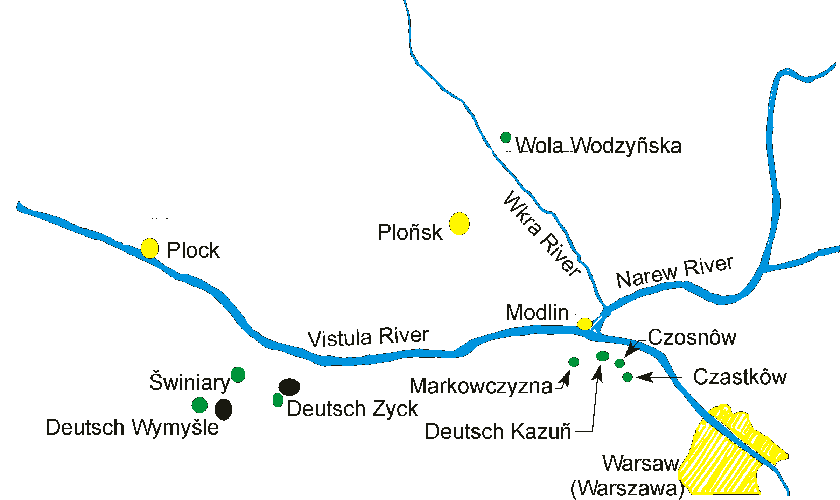Deutsch Wymyschle
One of the more prominent Mennonite congregations in Mazovia, near the Vistula river, was Deutsch Wymyschle, Wymyśl Niemiecki in Polish, so called to differentiate it from Polish Wymyschle [Wymyśle Polskie], the neighboring and earlier village, as Deutsch Wymyschle is now Nowe Wymysle, meaning New Wymyschle. This village and it's church were located about half-way between Warsaw and the western border of Mazovia.
Closer to Warsaw was another large congregation, Deutsch Kazun, which was acutally the first Mennonite congregation in Mazovia, founded in 1764, and called Kazuń Niemiecki in Polish.
The third congregation was quite a ways north, in Wola Wodzyńsk.
 |
| Mennonites in Mazovia |
Wymyśle Nowe (Wymyśle Niemieckie)
Unlike the village of Kazuń and the majority of the Dutch settlements, Wymyśle Nowe (Wymyśle Niemieckie, Deutsch-Wymysle) near Gąbin was not threatened by flooding of the Vistula. It was founded on the edge of the Równina (Plain) Kutnowska. Historians' opinions about their origins are divided. According to the discussion cited by Erich L. Ratzlaff, some researchers believe that the settlement dates from 1762 or 1764, while according to others, Wymyśle Nowe was founded by Lutherans in 1791, and Mennonites arrived there only in 1813. Of course, we cannot rule out the possibility that Mennonites settled in the village twice. Thus, it is possible that the first adherents of this faith, who probably originated from the Frisian communities, appeared in the areas to the northeast of Gąbin as early as 1760s and shortly afterwards moved farther east, while their place was taken by Lutheran colonists[18] . (Paweł Fijałkowski)
Then, at the beginning of the 19th century, the area was colonized by another group of Mennonites who came from Flemish communities and settled in Wymyśl. In 1813, they appointed their first minister and in 1815 began to keep the community chronicle. The majority (ca. 70%) of the Mennonites residing in the village between 1800 and 1860 originated from West Prussia. They primarily came from the following villages located in the Grudziądz and Chełno regions: Tryl [Treul], Zajączkowo [Sanskau], Przechówko [Wintersdorf], Konopat Niemiecki [Deutsch Konopat], Głogówko (?), Kępa Ostrowska [Świecki Ostrów, Ehrental], Dorposz, Łunawy [Lunau], and Jeziorka [Kleinsee]. The majority of other residents (ca. 25%) came from the Wielkopolska and Brandenburg borderland, including the villages of Brechenhofswalde and Głęboczek (Franztal) near Drezdenko[20] . (Paweł Fijałkowski)
The school in Wymyśle Nowe was probably established immediately after the settlement was founded and was initially a religious school. Later, the school was taken over by the education authorities and in 1842 functioned as an elementary school[27] . As a result, the curriculum was broader than that of a religious school, and religion was one of the taught subjects. The intention of the education authority was to provide the villages inhabited by Protestants with a teacher of an Evangelical denomination. Therefore, in most cases, also in Wymyśl, the teacher was usually a Lutheran. He also performed religious functions for the local Lutherans, that is, presided over services and funerals. The building of the school-house of prayer burned down ca. 1850 (in 1854 or according to other sources, at the beginning of 1860s). Following this disaster, the residents built a school and then in 1863, a separate Mennonite house of prayer, which was made of brick and covered with sheet metal[28] . (Paweł Fijałkowski)
“In 1762 Mennonite emigrants from the West Prussian congregations of Przechovka near Schwetz and of Montau-Gruppe near Graudenz made their way upstream into Poland and settled in the province of Warsaw, district Gostynin, not far from the town of Gobin, and founded the Deutsch-Wymysle village and congregation. In 1764 a second group arrived from Przechovka. In 1818-1820 and 1823-1824 a further considerable influx came from Przechovka and the Brenkenhoflswalde-Franztal congregation. Those who came in these last five years all joined the Deutsch-Wymysle congregation, although they settled for the most part in various villages in the adjacent German Vistula region, such as Piaski, Sordy, Korzykov, Vionczemin, Novosiadlo, Sviniary, Leonor Lyck, Piotrkovek, Lady, Arciechov, Januszev and Sladov.” (GAMEO “Deutsch-Wymysle”)
[Back to Mazovia] [Next to Vistula Life]
Sources
[1].Ravenstein, Ludwig. "An Atlas of the German Empire." UW-Madison Libraries.
Return To Histories Page
Return To Home Page
© 2019 Daniel Foote. Based on Template Designed by Andreas Viklund.